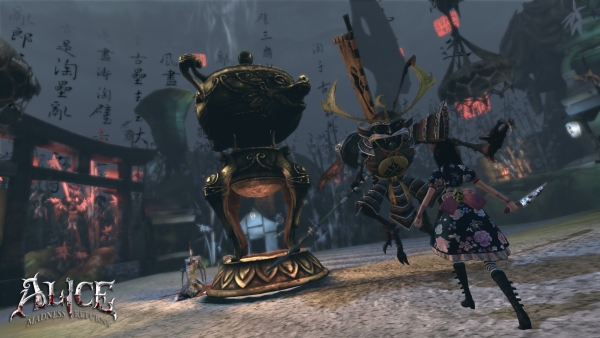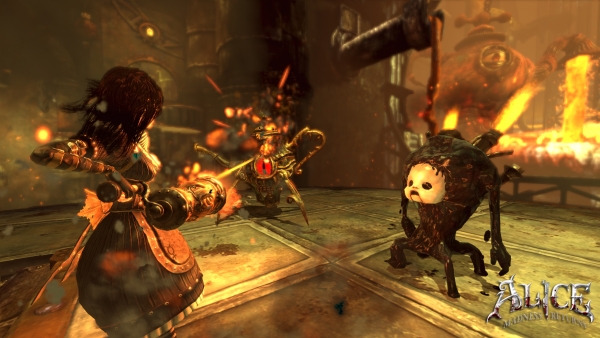
mad·ness, Noun
1. The state of being mentally ill, esp. severely.
2. Extremely foolish behavior.
3. The state of that grayish-pink thing in American McGee’s skull casing.
Only once before has American McGee dared to present an intriguing new spin on the classic tale of Alice in Wonderland. Alice: Madness Returns dives back into a nightmarish Wonderland where the very fabric of poor Alice’s mind is being torn asunder from overly long levels and a maddening lack of story. Let’s see if American McGee is insane. I certainly think so.
Platforms: PC, PS3 (Version Played), Xbox 360
Publisher: Electronic Arts
Developer: Spicy Horse
Genre: Platformy/Hackey/Slashy Drug-Induced Fever Dream
Release Date: June 14, 2011
ESRB Rating: Mature
Alice Liddel has been living in London since the fire that claimed the lives of her entire family. She has been in and out of psychiatric treatment while living and working at the local orphanage. Her mind has started decaying more rapidly. Her memories have become muddled and she frequently loses large chunks of time. There is trouble brewing in Wonderland once again. A sinister black corruption has been ruining Alice’s imaginary world and a gothic style train is smashing the landscape to bits. It is up to Alice – armed with kitchen knife, pepper shaker, and her hatred of baby dolls – to save Wonderland and her sanity.
Each chapter of Madness Returns starts with a stroll through a dark and dreary Sweeney Toddesque London. These jaunts through the depressing, but surprisingly intriguing, areas provide a stark contrast to the vibrant absurdity displayed when Alice loses her grip on reality.
Wonderland is a beautifully detailed environment that is a joy to explore even if it is a bit linear (I think the level designer from Final Fantasy XIII found a new job). The linearity doesn’t distract from the absolute spectacle that is this mad and broken Wonderland. The world inside Alice’s head should be a mash-up of wild whimsy and there is no shortage of that here. Although, it isn’t the sort of whimsy you would expose a small child to. After all, Alice does wield a bloody kitchen knife and believes she can fix things in her mind by stabbing them.
There is a common theme and setting for each section of the story. A few memorable levels are the Japanese-inspired journey up a mountain to visit the hookah-smoking caterpillar and the house of cards impossibly floating high above Wonderland. But many of the levels feel long and drawn out, and by the end of them you’re relieved to get back to London for a spell.

There are some puzzling choices littered throughout the game. Not puzzles… that would have been fun and appropriate. Occasionally, you will be tossed into a 2D shooter or platforming level. Alice might have an uncontrollable need to ride down some of Mario 64‘s slides. There is even baby doll-head Plinko and I still have no idea what the hell that is… and I played it. Evidently, the designers had been hanging out with the caterpillar too much. All of it just served as a poke in the eye to any sort of immersion.
More is not always better, Spicy Horse. I know when you are high, you want to eat all the Funyuns and Butterscotch Krimpets in the nearby convenience store, but sometimes restraint is needed or else you will end up looking like the corpulent Tweedledee and Tweedledum. Take all that time you spent developing the sliding mechanics, 2D shooters, and baby doll Plinko to focus on tightening up the levels and story to give it some pacing, excitement, and soul.
A quick side note on design: American McGee must have been taking a hand out from the American Girl doll company because there are literally baby doll faces on everything. They litter the flesh of the amorphous corrupted in every single level. A hairless, eyeless baby doll face is creepy, but anything ceases to be unnerving around the one thousandth time you’ve seen it.
I could ramble on about the design all day, how it is all very pretty and how the studio obviously took its time to lovingly render the concept art into cut scenes, but what really is at the heart of a game is the actual gameplay. I’m pleased to say that it is an improvement over the original even if it is a familiar and tired old horse. The control scheme is simple and very reminiscent of Darksiders. Each weapon is functional, but I found it really satisfying to bludgeon enemies with the hobby horse. As you land a few blows, Alice pirouettes gracefully into the air and brings down the the whinnying horse head on your nearest soon-to-be-bloody opponent. I occasionally caught myself giggling maniacally as I bashed another baby doll blob into oblivion. Once you upgrade the vorpal blade fully, you are as cunning with it is as a hibachi chef while tearing apart the Card Guards at the Red Queen’s palace.
Sadly, the story of Alice: Madness Returns is nowhere near as compelling as the design. There was a wealth of material to sift through for inspiration. Alice has the potential to be a wondrously dynamic character. She needs to claw her way out from the icy grip of madness as she sets Wonderland right in her own head. That premise alone should be compelling enough to hang a story for a game. Instead we get Mario style slides and baby doll plinko.

The dialogue in Alice is dense, but surprisingly bland and uninteresting. It really doesn’t do much to drive the plot or enrich the player in any way. This is Wonderland. There should be a bit of humorous wordplay. There was a disappointing lack of nonsensical words like “snorkleblat” and “fahrvergnügen” or “juggalo.”
For all of my complaints, I actually enjoyed wandering about Wonderland. Sure, it can get monotonous at times and the story is severely lacking in any motivation whatsoever, but you move forward just to see what insanity will be bombarding your eyes next. The combat is fast, enjoyable, and satisfying. It is a unique and nightmarish vision of Wonderland that is just enough to keep you slogging through the rough patches. Hidden within the game are a few flashes of true genius but it is overall a triumph of style over substance.
If you get tired of Madness Returns, you can redeem the code in the box and download your free copy of the original American McGee’s Alice. I can’t help but wonder if Spicy Horse knew Madness Returns wasn’t superb and added this perk as a way of an apology.
I desperately wanted to like Alice: Madness Returns more than I did for having a unique vision and taking some chances, but a game needs to juggle a lot of things in order for it to be good. Sadly, Alice drops a ball or two. But it does have a bit of charm, and it’s something different from anything else you will find on the your video game merchant’s shelf. Give it a try. You may just enjoy the view through American McGee’s looking glass. Ah, the white rabbit is giving me a stern look and tapping his pocket watch. It seems that I’m late for my train!

Review Disclosure: A retail copy of Alice: Madness Returns was purchased by Warp Zoned for the purposes of this review.







